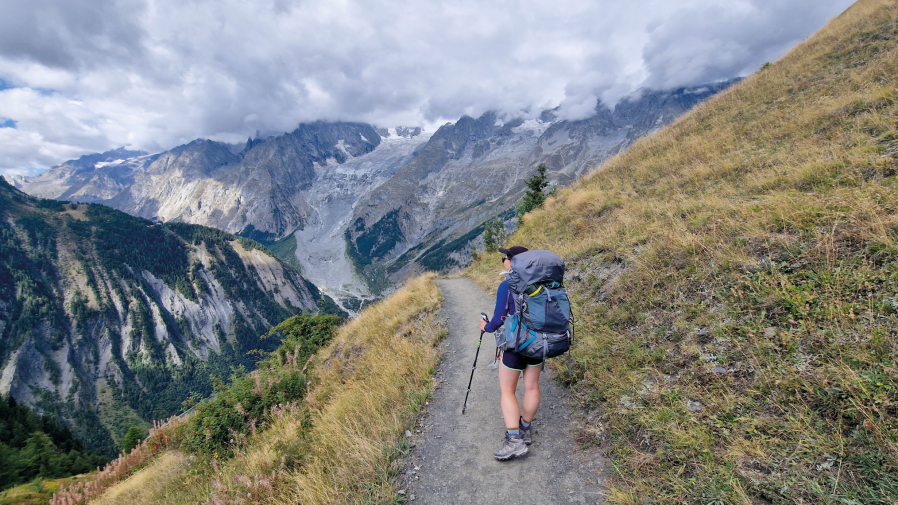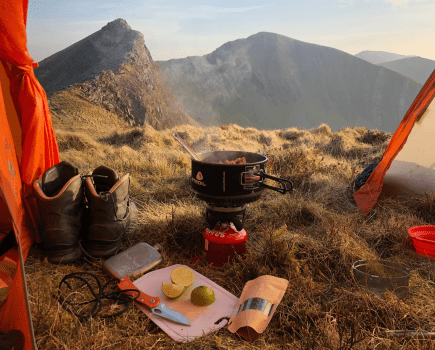Multi-day hikes have taken me deep into the world’s most spectacular landscapes. But there’s an art in preparing to walk into the ‘wild’ for days on end.
Multi-day hiking is a perfect next step for any day hillwalker wanting to take that next challenge or step into nature immersion. It’s taken me deep into breathtaking landscapes across the UK and the Alps. By traversing the land slowly, you can get to know it intimately, feeling the terrain change underneath your boots and visiting towns and villages you’d normally pass by in a car or train. From the comfort of your own tent, you’ll get to see spectacular sunsets, sunrises, and stars from where you sleep.
Main image: On the Tour du Mont Blanc | Credit: Ingrina Shieh
Personally, I find multi-day trekking incredibly beneficial for my mental health, too. In its simplicity, the act of walking is a powerful healer. Each meditative step towards a summit can prove to be one farther from stress, anxiety, and depression. Whether I’m giving a last push to a trig point or crossing a ridge, my mind remains in the present and slows–then quiets–down. While they’re never easy, multi-day hikes make the very act of walking an adventure.
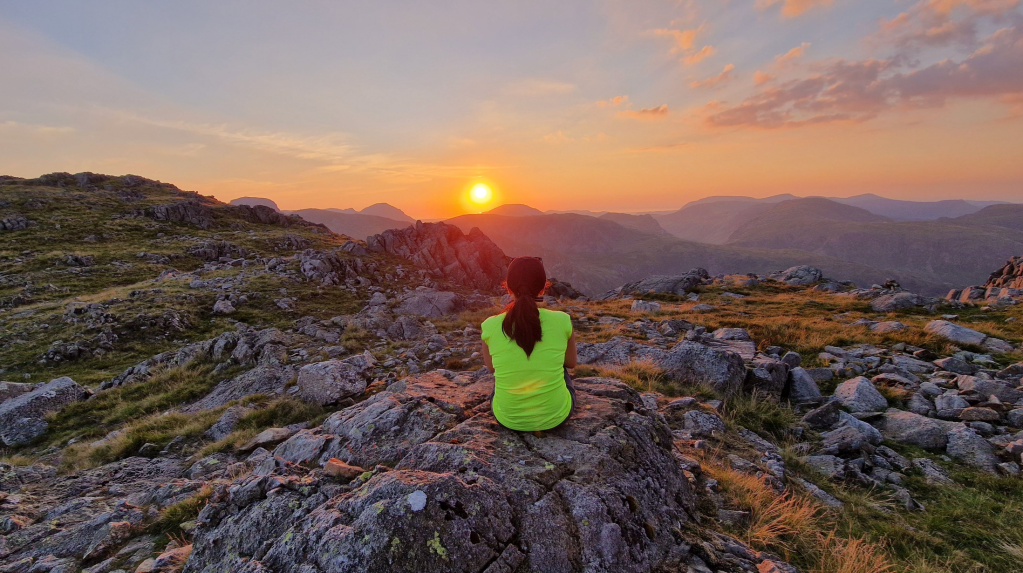
Multi-day hiking can offer moments of peace like this one in Lakeland. Credit: Ingrina Shieh
What is multi-day hiking?
Multi-day hiking is hiking for two more days to complete a trail from end to end. It can be known as backpacking or trekking. Thru-hiking is hiking an established long-distance trail end-to-end continuously, and section hiking is hiking a section of an established long-distance trail.
One of the best things about multi-day hiking is that you can tailor it to your own style, but it’s very different to day hikes and takes more preparation. Here are some tips to get you started.
How to pick a trail
It can be daunting to choose a trail. You can save time deciding by thinking through what you’re looking for. For example, how long and how far can you walk a day? Do you want to do a high level or low-level hike? For the first trip, consider reducing daily mileage, and remember that terrain and elevation impact your pace.
Where and when you want to go might have implications on the weather and the amount of daylight you have. What kind of accommodation you’d like to stay in – hotels, huts, B&Bs, bothies, campsites, or wild camps – can help you plan your itinerary.
Assess your own hiking experience carefully. Remote trails are wonderfully quiet, but offer few exit opportunities or alternatives. Popular, well-established trails have great infrastructure and resources.
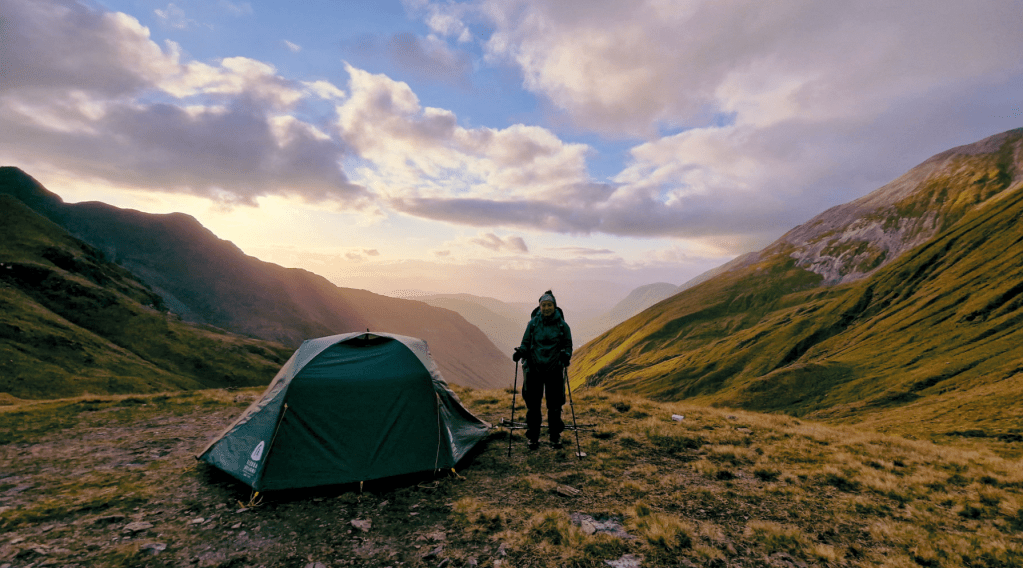
A high camp in the quiet Mamores. Credit: Ingrina Shieh
Kit
Bring your walking gear, including maps, compass, food, hydration kit, whistle, head torch, layers of clothing to keep you warm or cool, first aid kit. Consider seasonal factors and pack other essentials (such as sun cream, tick tweezers and midgie nets). For a multi-day hike, you’ll have to bring a little more and consider excluding comfort items. Navigation is crucial so make sure you bring a waterproof protection case for your maps and a power bank to charge devices.
Kit doesn’t need to be expensive but waterproofs must be reliable. No matter what the forecast says, the more days you’re out, the higher the chance of varied weather, especially if at higher elevations. Invest in waterproofs (and dry bags) you can trust.
If you’re camping, you’ll need a backpacking tent, sleeping bag, inflatable/folding mat, and other sleeping kit suited to the weather you’re expecting. You’ll also likely want to bring a stove, pots, and cutlery for meals.
Ingrina’s ‘Extra Essentials’
- Water filter and purification tablets
- Walking poles
- Cap to protect your head and to keep your face and eyes dry if it rains
- 45L-65L rucksack (and rain cover)
- Dry bag(s)
- Gaffa tape for temporary fixes
- Insect spray
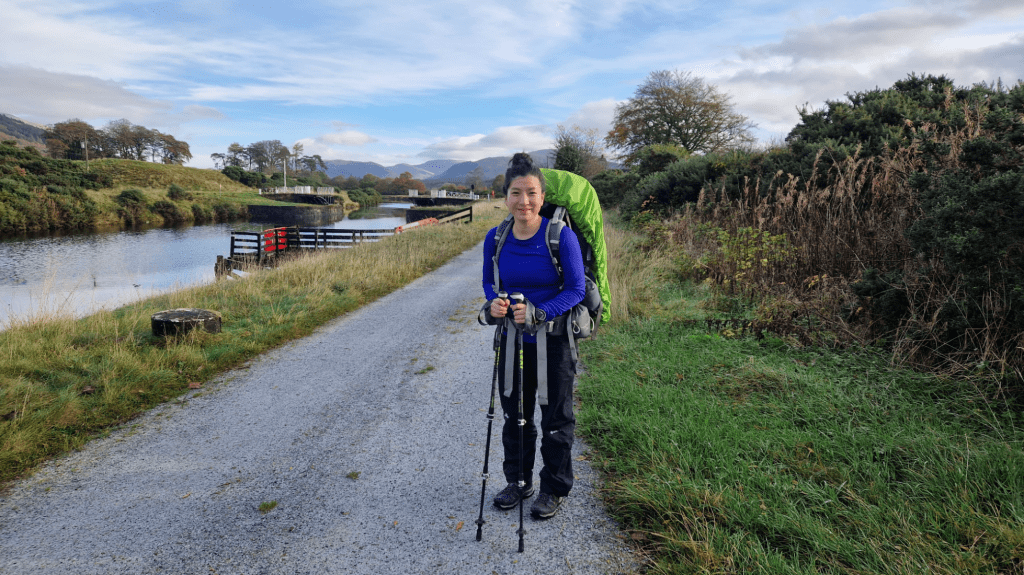
On the Great Glen Way. Credit: Ingrina Shieh
Knowledge and skills
What you need to know and be able to do for day hikes can transfer to a multi-day hike, but you’ll want to brush up or learn on a few skills.
Navigation: While you can upload a GPX file onto a navigation apps or follow signs on a well-marked trail, basic map reading skills are recommended. If you can’t do a map reading course, have a look at Ordnance Survey’s guide.
Planning: This is essential to make sure you know where you’re going, where you’ll stay, and what supplies you’ll need and where/when to get them.
Self-sufficiency: Know how you’ll prepare food, where you’ll get water, and how to brave all elements. This is less important if you choose a trail that passes through settlements frequently.
Flexibility: You must be willing to abandon the trail if something goes awry, whether it’s turning back or opting for a different route. The trail will be there for you the next time, so make sure you are.
Fitness preparation
Being physically prepared will give you the best chance of enjoying the hike, and you’ll need to prepare your body for consecutive days on your feet. Give yourself a few months to train and test your kit. Do back-to-back walks, whether from your house or on a 2-day hike. This will help your body get used to moving on fatigued legs.
Remember that in addition to being on your feet, you’ll be carrying a heavier rucksack. Try hiking with extra weight to build strength – put in books or more water in your rucksack, for example. Cardio exercise can also help with preparing for the physical demand of a multi-day hike. If your trail includes elevation gain, walk up and down hills or take the stairs.
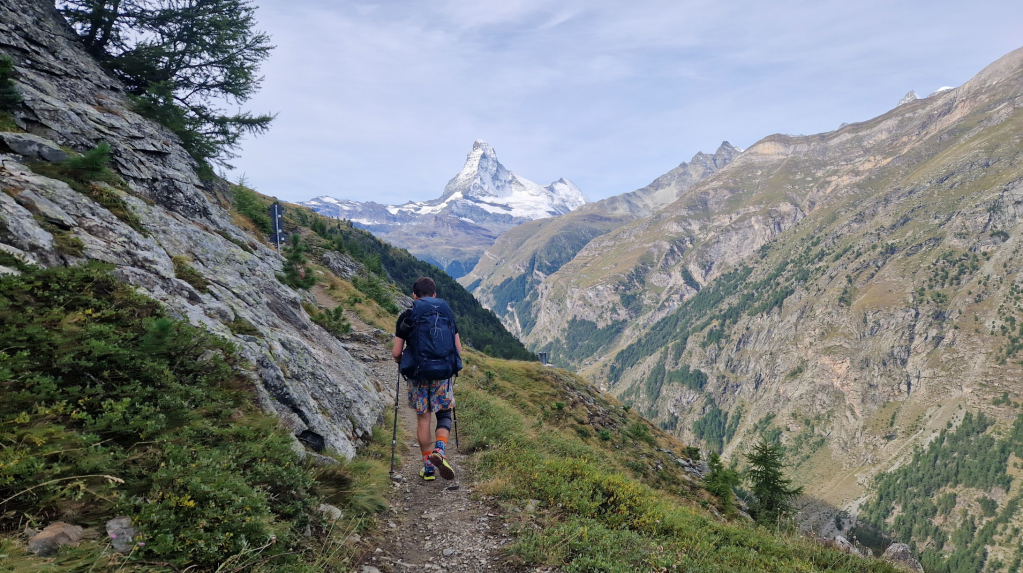
The Walker’s Haute Route. Credit: Ingrina Shieh
Ingrina’s extra hard-earned tips and tricks
Tweaking strategy and kit is part of multi-day hiking. You’ll likely learn your own lessons and how to lighten your load or pack more efficiently, but here are some of my tips – and some of the mistakes I made on my first backpacking trip!
Be prepared for rain at any time in the mountains, even if the forecast says otherwise. But if you can, check the weather forecast (Met Office’s mountain forecasts and the MWIS is recommended) daily. Sometimes hours make all the difference!
For navigation, I bring digital and paper maps. In the UK, I use Harvey or OS maps, and for international trails I use Komoot. For offline maps on your mobile, you might have to pay a one-off fee or a subscription, but it’s worth it. To conserve your battery on the trail, put your phone on airplane mode and turn off the bluetooth.
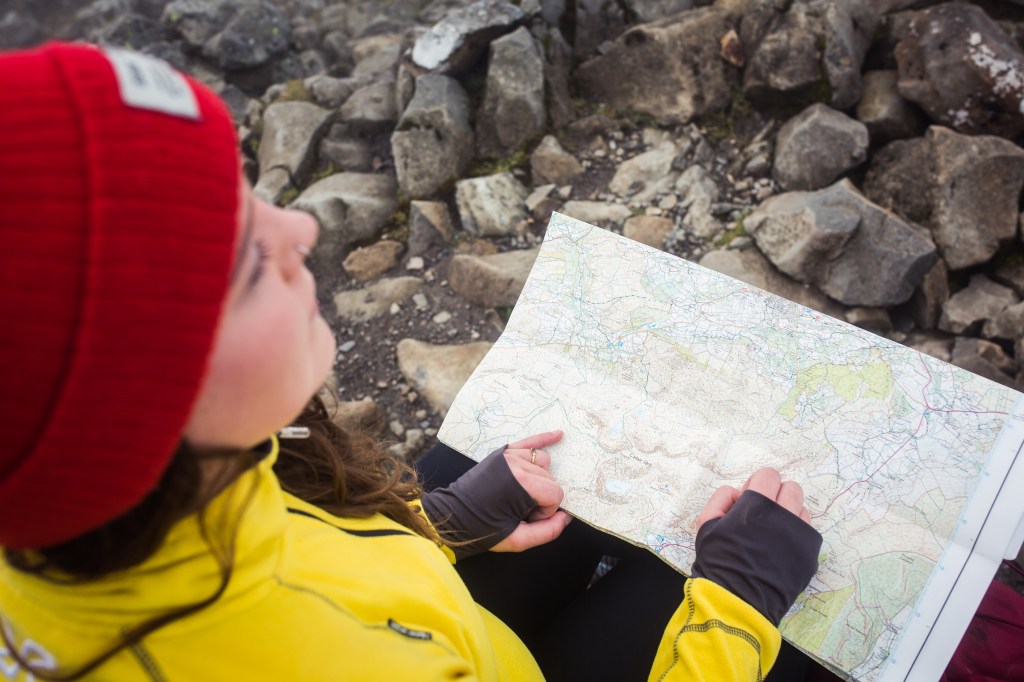
A walker checking their OS Map at the summit of Cadair Idris. Credit: Jessie Leong
If you can’t do an entire trail, opt for a section hike. Not everyone can take months off to do a thru-hike. Section hiking is a great way to get to know and complete a trail.
If you plan your own route, do your research. Maps won’t necessarily tell you if a footpath is technical and you’ll need more gear.
If you’re new to multi-day hiking, an established trail is a great introduction. While it will be popular, it will have good amenities, facilities, and exits, and opportunities to socialise with other hikers.
If you don’t want to carry a heavy rucksack, most popular trails have luggage transfer services so you only need a day pack. Bear in mind, though, that these offer less flexibility on itinerary.
Guidebooks provide useful advice and tips. I’ve discovered gorgeous variants and learned more about the history of places through these books.
Lastly, embrace the adventure! You can plan meticulously and still make mistakes, and that’s OK! Multi-day hiking is all about enjoying the outdoors, and part of that is the journey towards figuring out what works for you. I carried a hair dryer and straightener on my first trip, so you’ll probably begin better than I did!
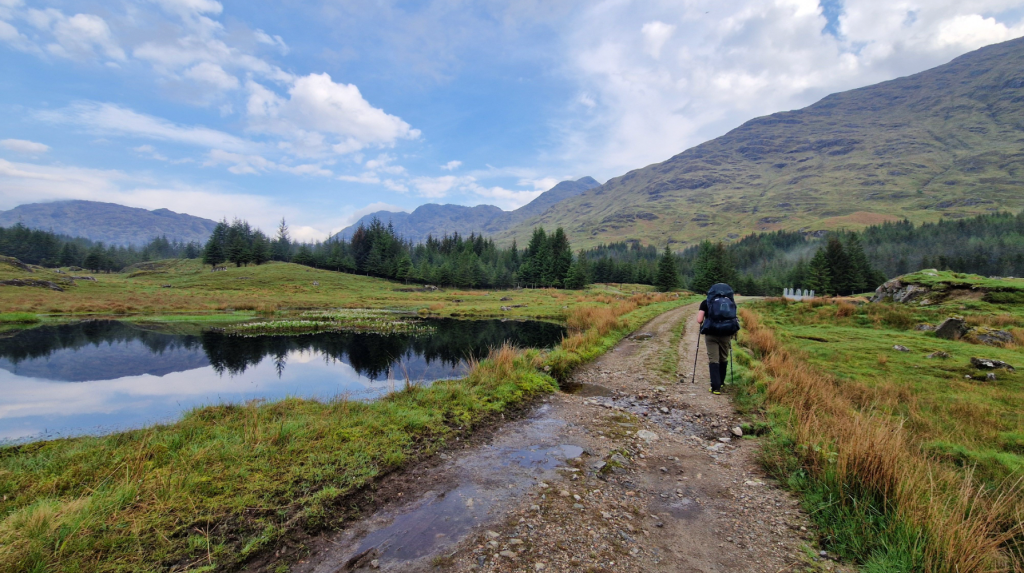
The Cape Wrath Trail is one of the most difficult treks in the UK. Credit: Ingrina Shieh
Ready for multi-day hiking?
Here are some beginner-friendly trails Ingrina recommends
West Highland Way, Scotland: ~6-9 days
Tour du Mont Blanc, France, Italy, Switzerland: ~8-12 days
Great Glen Way, Scotland: ~4-6 days
South Downs Way, England: 7-9 days
Hike further: long-distance trails in the UK and Ireland The Great Outdoors recommends – plus full trail guides

